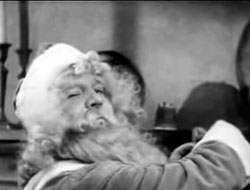 The one-reel black & white Castle Films version of The Night Before Christmas (1949) was made for the home-movie market.
The one-reel black & white Castle Films version of The Night Before Christmas (1949) was made for the home-movie market.
Castle Films distributed many Christmas shorts & became an important part of Christmas celebrating during the 1940s & '50s, including Howdy Doody's Christmas (1952), A Christmas Dream (1945), Christmas Toy Shop (1945), Santa Claus's Punch & Judy Show (1948), Hardrock, Coco & Joe: The Three Little Dwarves (1951), & a great deal more.
It's not that Castle's was only a family-oriented product line, as the company equally celebrated fear of the Atomic bomb, paranoia about communists, war propoganda financed by the government, besides such innocuities as musical performances, cartoons, & condensed horror & comedy movies.
The Night Before Christmas opens on a nice snowy homestead, then we enter the house through a leaded glass window. The narrator is reciting the famous "Visit from St. Nick" by Clement Clarke Moore (1779-1863). This poem is the subject of a great many Christmas shorts & cartoons, & many manage to include a lot that is not really part of the poems.
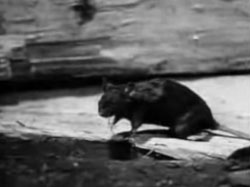 Upon the line "Not a creature was stirring, not even a mouse," there's an accidental moment of discord as the camera pans past what really appears to be a taxidermed roof rat. Upon the line "Not a creature was stirring, not even a mouse," there's an accidental moment of discord as the camera pans past what really appears to be a taxidermed roof rat.
Each line of the poem gets an illustrative scene. The children in their beds "with visions of sugar plums" is accompanied with animated images of dancing pears & candy canes.
The mixture of live action & animation continues as the father of the household throws open the window & we cut to a cartoon of Santa & his sleigh driving hard over the snow, under a smiling moon. A close up of a live-action Santa recites the reindeer names.
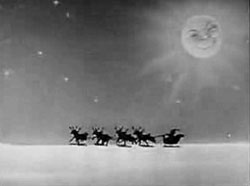 We see Santa unload his bag of toys from the sleigh & climb down the chimney. He puts toys in the stockings, laughing as if to wake the dead. He then lights up his pipe & plays with one of the toys. By a wave of his arms he causes the tree to be fully decorated. We see Santa unload his bag of toys from the sleigh & climb down the chimney. He puts toys in the stockings, laughing as if to wake the dead. He then lights up his pipe & plays with one of the toys. By a wave of his arms he causes the tree to be fully decorated.
The visual content & narration are so closely tied that I could not resist revising it a bit myself: "Then laying a finger alongside his nose/ Came forth a big snot-wad as gamely he blows."
Back up the chimney he goes & away flew the sleigh. The three kids are by now rising & tearing into their stockings, as we see a final animated sequence of Santa & his reindeer in the sky, & a final close-up of the live Santa wishing us a happy Christmas.
All nicely straightforward & it must've delighted a lot of kids through the 1950s when the home projector was trucked out.
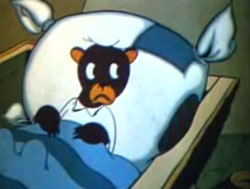 All the animals are just so happy in the woodlands, as they've not yet seen Jack Frost (1934), & the weather has been so pleasing. However, winter is on its way! All the animals are just so happy in the woodlands, as they've not yet seen Jack Frost (1934), & the weather has been so pleasing. However, winter is on its way!
The beasts are seen in this Technicolor classic playing leapfrog, all sorts of species getting along with one another. A grizzly bear cub is having especially great fun leaping over everybody one after another.
Jack Frost shows up & sings instructions about how to prepare for winter. The animals sing lyrics, too, about how industrious they'll be making preparations.
But the baby bear says he doesn't have to worry, because he's good & furry. His mommy warns him he'll sing a different tune when he meets Old Man Winter.
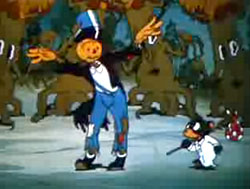 Mommy leads her son to his hibernation bed. But he has no intention of staying in bed all winter long. When mom's asleep, the little bear wraps up a couple of toys in a bandana, hangs it on the end of a stick, & runs away from home. Mommy leads her son to his hibernation bed. But he has no intention of staying in bed all winter long. When mom's asleep, the little bear wraps up a couple of toys in a bandana, hangs it on the end of a stick, & runs away from home.
Jack Frost with his paint brush is painting pumpkins orange, & painting crystals on windows, & suchlike.
He warns the grizzly cub to look out for Old Man Winter. The bear continues to insist, by song lyric, that he doesn't have to care. He soon encounters a dancing scarecrow who is doing a a bit of Cab Calloway scat. (Cab shows up in scads of cartoons of the era. Several such are reviewed on the Animated Cab Calloway page.)
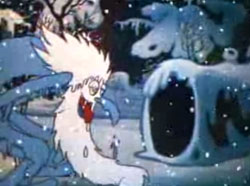 The cub still insists he doesn't have to worry, just as Old Man Winter shows up & turns the autumn scarecrow into a winter snowman. The cub still insists he doesn't have to worry, just as Old Man Winter shows up & turns the autumn scarecrow into a winter snowman.
This Old Man Winter is "borrowed" or just plagiarized from the Max Fleischer Betty Boop & Cab Calloway classic The Old Man of the Mountain (1933), so the Calloway referencing is a double-whammy.
Soon the cub is desparately looking for a warm den, but none of the other animals have room for him, except the skunk, but he can't stand that. Winter traps him in a hollow log, with ice-sickles as prison bars.
Jack Frost comes by to save the cub, turning the ice-bars into candy cane popsickles after the bear begs to be in his nice warm bed.
This is a superb cartoon & a major homage to Max Fleischer. It can be found on several different compilation discs of Christmas cartoons, or of Ub Iwerks cartoons.
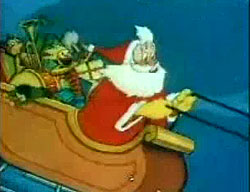 A Paramount "Noveltoon" in Technicolor, from Famous Studios, Santa's Surprise (1947) is a jaunty little cartoon. It opens with Santa already in the skies making deliveries, & singing in baritone voice about his once-a-year task. A Paramount "Noveltoon" in Technicolor, from Famous Studios, Santa's Surprise (1947) is a jaunty little cartoon. It opens with Santa already in the skies making deliveries, & singing in baritone voice about his once-a-year task.
As he make his deliveries all around the world, we see some gorgeous, layered cityscapes. Several of the children have managed to stay awake to spy on Santa.
After he returns to the Pole, he goes sleepily to bed, & outside in his sleigh, it turns out those children had sneakily stowed on board!
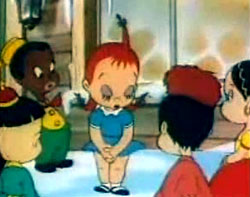 With Little Audry as their leader, these seven children sneak out from the back of the sled & enter Santa's residence. Though relying on race stereotypes, a good deal of credit has to be allowed, in that these kids represent all races. With Little Audry as their leader, these seven children sneak out from the back of the sled & enter Santa's residence. Though relying on race stereotypes, a good deal of credit has to be allowed, in that these kids represent all races.
The children feel sorry for Santa, as he works so hard, & gets so tired, but nobody brings him presents on Christmas. They decide they'll tidy his messy home & workshop.
They try not to make any noise, but that's almost mipossible for seven children. The Dutch boy spinning around on the Victrola as it blasts "Jingle Bells" speeded up is one of the best noisy-kids gags.
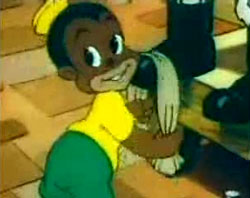 But Santa snores away, as Audry starts out the song, "We Wanna Do Something for Santa." But Santa snores away, as Audry starts out the song, "We Wanna Do Something for Santa."
The script manages to find "ethnic" (but really only stereotypical) tie-ins to most of the cleaning duties, like the black kid shining Santa's boots "to a boogy beat" as he describes of himself. Or the Chinese kid doing laundry.
These are minor offenses of racism that have the effect of negating the well-intended inclusionary nature of the script. But so long as the "times" are forgiven, the cartoon is, overall, damned cute. It's very sweet that the kids are genuinely selfless.
When Santa does wake up, he finds not only that the house is tidied, but he has a gift under his tree! Quite a beautiful one in fact. The kids have left by then, though I couldn't help but suppose they all froze to death never having realized what they were facing out there in the cold.
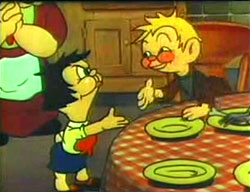 Van Beuren Studios generally made rather primitive low budget black & white cartoons, but A Waif's Welcome (1936) was done with RKO funding in full color as a "Rainbow Parade" Christmas cartoon, & very well designed.
Van Beuren Studios generally made rather primitive low budget black & white cartoons, but A Waif's Welcome (1936) was done with RKO funding in full color as a "Rainbow Parade" Christmas cartoon, & very well designed.
Junior, a snotty troublemaking little boy who deserves a good smacking, is contrasted with a kind, gentle little orphan outside the storm, trying to sell newspapers on Christmas eve.
The wind blows snow around a lamp post, turning it into a giant snowman with frightening light-beam eyes. The orphan's newspaper blows away, to be read by the snowman, & we see by the headline that it's last summer's paper.
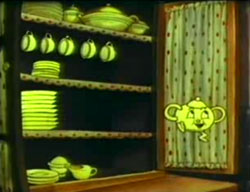 "I ain't gotta home. I'm an orphan," he tells Juniors' mother, & she invites him indoors to feed him a great meal, then offers him a home. Like that'd ever happen. "I ain't gotta home. I'm an orphan," he tells Juniors' mother, & she invites him indoors to feed him a great meal, then offers him a home. Like that'd ever happen.
The orphan gratefully does the dishes & is helpful around the house. "Big sissy!" says Junior, & does what he can to undermine the intruder, getting him blamed for terrible actions that were actually Junior's doing, including setting fire to the piano.
"You go back where you came from!" shouts the father, & kicks the orphan back into the storm.
Deciding to teach the kid a lesson, the orphan returns that night & by hallooing down the chimney, fakes a haunting to induce guilt & confession, so that the orphan is welcomed back into the home. I like the primitive Van Beuren cartoons better.
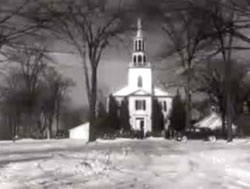 Christmas 1950 is the December 1950 "issue" of a screen magazine, about five minutes of footage taken by various Pathe newsreel cameramen. Christmas 1950 is the December 1950 "issue" of a screen magazine, about five minutes of footage taken by various Pathe newsreel cameramen.
It begins with a text card, "As the spirot of Christmas united all humanity...the News Magazine of the Screen presents, from around the world, the spirit of Peace on Earth Good Will Toward Men."
The United States is represented first, by a chorus in church singing "Silent Night." The same chorus continues to sing, however, as a scene of Christmas in England is provided, a pump organ accompanying choir boys.
Next up is Holland, with an instrumental rendition of "The First Noel" accompanying a candlelit scene with nativity & people in phony Dutch costumes, perhaps in some sort of Christmas mummery. Then comes a gloomy scene of going to church in France, with sad looking worn-out grim faces, a bit of holiday misery that is startling in such a christmas-cardish film.
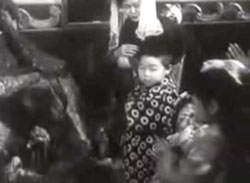 For Sweden we see family visiting a very frightening masked figure of some Santa parallel, & the music has changed "It Came Upon a Midnight Clear," still on the soundtrack for Switzerland, which seems to be a family home with enormous Christmas tree. For Sweden we see family visiting a very frightening masked figure of some Santa parallel, & the music has changed "It Came Upon a Midnight Clear," still on the soundtrack for Switzerland, which seems to be a family home with enormous Christmas tree.
Then we're off to Korea for images of people freezing in the cold, the only scene without noticeable religious associations.
Then a Christian church in Japan has "Silent Night" back on the soundtrack againl. Nicely dressed up Japanese children, taken before a nativity, show no interest, but adults seem pious.
Then there's Canada, showing a snowy countryside & going to church in a one horse open sleigh, preying within to Mary. In Mexico ("Siletn Night" still being sung by the chorus we heard at the start) we see some nice archetecture of a Cathedral & ornate Mother & Child altar with Catholic families worshipful.
Pretty much just for Christians. Attractive-of-kind, but no real content that would extend interest outside of church.
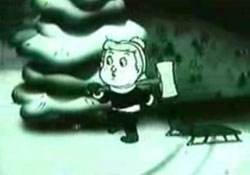 One of the strangest damned Christmas cartoons is a scant minute long. The soundtrack consists of the title song, A Merry Christmas for All the World (1959). It's a creepy story-song that tells us exactly what we're watching.
One of the strangest damned Christmas cartoons is a scant minute long. The soundtrack consists of the title song, A Merry Christmas for All the World (1959). It's a creepy story-song that tells us exactly what we're watching.
A nice fir tree family lives in the snowy countryside. There's momma tree, & daddy tree, & between them is baby tree, named Junior, who is growing a bit each day, & his parents so proud.
Into the woods comes a little boy with sled & axe. The traumatized tree family conveys their horror, momma tree screaming "Junior!" while reaching for him protectively with her limbs. Junior shouts out his last word in life, "Timber!" Presumedly the human child cannot hear these cries of horror as he hacks down & hauls slain Junior away.
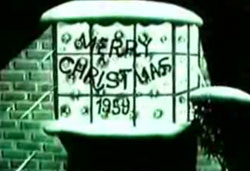 Grief-stricken Momma & Daddy tear out their own roots from the snowy ground. With roots like feet, they chase after their baby, following the track of the human child's sled. Grief-stricken Momma & Daddy tear out their own roots from the snowy ground. With roots like feet, they chase after their baby, following the track of the human child's sled.
They come to a little house & see Junior through a window, all decorated for Christmas. This apparently makes them happy, as though Junior's life were given to a good cause.
There's no evidence the makers of this cartoon intended it to scare the bejezus out of any child who dares to think about its "kill a tree for Jesus" context.
Encountered on youtube, I've not found who the animator might be. It was probably made as pre-film filler by one of the same companies who made "let's all go to the lobby" type theater ads, but might've been made for early television, as in the 'fities stations kept lots of short-subjects on hand to fill out hours whenever too few ads had been sold.
copyright © by Paghat the Ratgirl
|
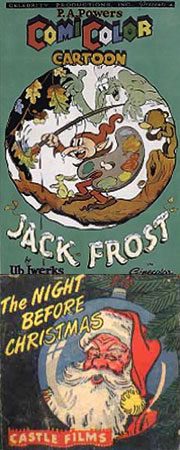

 Upon the line "Not a creature was stirring, not even a mouse," there's an accidental moment of discord as the camera pans past what really appears to be a taxidermed roof rat.
Upon the line "Not a creature was stirring, not even a mouse," there's an accidental moment of discord as the camera pans past what really appears to be a taxidermed roof rat. We see Santa unload his bag of toys from the sleigh & climb down the chimney. He puts toys in the stockings, laughing as if to wake the dead. He then lights up his pipe & plays with one of the toys. By a wave of his arms he causes the tree to be fully decorated.
We see Santa unload his bag of toys from the sleigh & climb down the chimney. He puts toys in the stockings, laughing as if to wake the dead. He then lights up his pipe & plays with one of the toys. By a wave of his arms he causes the tree to be fully decorated.
 Mommy leads her son to his hibernation bed. But he has no intention of staying in bed all winter long. When mom's asleep, the little bear wraps up a couple of toys in a bandana, hangs it on the end of a stick, & runs away from home.
Mommy leads her son to his hibernation bed. But he has no intention of staying in bed all winter long. When mom's asleep, the little bear wraps up a couple of toys in a bandana, hangs it on the end of a stick, & runs away from home. The cub still insists he doesn't have to worry, just as Old Man Winter shows up & turns the autumn scarecrow into a winter snowman.
The cub still insists he doesn't have to worry, just as Old Man Winter shows up & turns the autumn scarecrow into a winter snowman.
 With Little Audry as their leader, these seven children sneak out from the back of the sled & enter Santa's residence. Though relying on race stereotypes, a good deal of credit has to be allowed, in that these kids represent all races.
With Little Audry as their leader, these seven children sneak out from the back of the sled & enter Santa's residence. Though relying on race stereotypes, a good deal of credit has to be allowed, in that these kids represent all races. But Santa snores away, as Audry starts out the song, "We Wanna Do Something for Santa."
But Santa snores away, as Audry starts out the song, "We Wanna Do Something for Santa."
 "I ain't gotta home. I'm an orphan," he tells Juniors' mother, & she invites him indoors to feed him a great meal, then offers him a home. Like that'd ever happen.
"I ain't gotta home. I'm an orphan," he tells Juniors' mother, & she invites him indoors to feed him a great meal, then offers him a home. Like that'd ever happen.
 For Sweden we see family visiting a very frightening masked figure of some Santa parallel, & the music has changed "It Came Upon a Midnight Clear," still on the soundtrack for Switzerland, which seems to be a family home with enormous Christmas tree.
For Sweden we see family visiting a very frightening masked figure of some Santa parallel, & the music has changed "It Came Upon a Midnight Clear," still on the soundtrack for Switzerland, which seems to be a family home with enormous Christmas tree.
 Grief-stricken Momma & Daddy tear out their own roots from the snowy ground. With roots like feet, they chase after their baby, following the track of the human child's sled.
Grief-stricken Momma & Daddy tear out their own roots from the snowy ground. With roots like feet, they chase after their baby, following the track of the human child's sled.